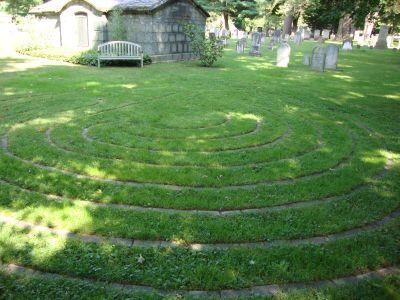A Guide to Walking the Labyrinth
What is a labyrinth?
A labyrinth is not a maze. It is a walking path that always leads to the center. As long as you stay on the path, you will get there.
Labyrinths have been used for thousands of years as aids in meditation and prayer. They have been used by people around the world and in most religious traditions.
We at St. James’ invite you to walk our labyrinth in your larger walk with God.
Christians have used labyrinths from earliest times, though they gained wide use in the Middle Ages. For poor Europeans in medieval times, walking a labyrinth served as a way of going on pilgrimage without venturing far from home.
Later, the benefits of this circuitous walk became evident to many, and their popularity grew. However, as the Middle Ages faded, so did awareness of the labyrinth.
Today, labyrinths are coming back into common use. Although there are countless variations, the most available forms of labyrinth found today are the 11-circuit “Chartres” labyrinth (so named because the most famous one is in a Cathedral in Chartres, France), and the 7-circuit “Cretan” labyrinth (given this name because the oldest version is found on the island of Crete).
The labyrinth at St. James’ is the Cretan version, used here because it fits better in the available space.
Why walk a labyrinth?
As ancient peoples knew, and as modern psychology has rediscovered, human beings use their bodies not only to get around but to reconnect with the spiritual. Prayer is an inherently physical act, which is why we often kneel, stand or fold our hands in prayer.
Or, as St. Augustine said, “It is solved by walking….”
Walking has a way of naturally quieting the mind. Walking a path where you don’t have to think, where all you need do is put one foot in front of the other, allows you to focus on the motion of your body and gradually let go of thoughts and worries.
In addition, walking the labyrinth simply feels good. It draws a person to it as an invitation to go inward.
For those who say, “I don’t know how to pray or meditate,” the labyrinth is a good way to start. All it requires is walking and trusting the path.
As self-consciousness fades, the act of walking naturally quiets the mind and allows the walker to hear God or simply become more conscious of God’s presence.
How do I walk the labyrinth?
There is no right or wrong way to walk the labyrinth. But there are some suggestions to help you get the most out of your walk.
First: Remember that this is not “magic.” You may have a profound spiritual experience the first time you walk it, or your might feel nothing at all. In either case, however, the very act of opening yourself to God will bring you further in your spiritual life.
Second: Walking the labyrinth is not a one-time event. It can be walked over and over again, even several times in succession if that feels right.
Third: Walk at whatever pace feels right. Whether slow or fast, let it be the pace that flows most naturally for you. If someone else is on the path and you need to pass them, do so gently and respectfully. In the same way, if another walker needs to pass you, simply step aside to let them continue at their pace.
Fourth: It is good to start each walk with some act of spiritual significance to you. You may cross yourself, bow or perform some other act. This sets the tone for your walk.
Fifth: Trust the path. Especially for your first walk, let go of worry about where the path leads — it will not lead you astray.
Sixth: If you get tired, you can simply leave the path. Don’t feel forced to continue when you can’t.
One Method of Meditating with the Labyrinth
In entering the labyrinth, you may choose to begin by allowing yourself to be open to whatever God may reveal to you. That takes any burden away from having to “make something happen.”
However, if there is an issue you are sorting through or a question that has your attention, you may want to hold that issue or question up to God, using it as a focus for your meditation. The walk may help bring illumination.
One of the traditional Christian meditative methods is called “The Three-Fold Path,” and it has three stages.
Purgation: It means “to purge,” to clean or let go, or to empty. In modern terms, it is a way of letting go of the world and its concerns. Imagine carrying all of your concerns in a backpack, setting the backpack down by a tree, and walking off.
In the labyrinth, the walk inward, toward the center, can serve as a cleansing or a letting go, as the act of quieting the mind.
Illumination: This means meditation or prayer. The Rev. Dr. Lauren Artress, one of the leading experts on labyrinths in Christian use, writes, “Often people at this stage in the walk find insight into their situation in life, or clarity about a certain problem, hence the label ‘illumination.’”
In the labyrinth, illumination finds its place when you reach the center. Here you may sit or stand and pray, now that you are ready. Stay as long as you like — it is your time.
Union: The third stage begins when you leave the center of the labyrinth and continues as you retrace the path that brought you in. This stage, to coin a phrase, gives legs to the insights you have gained in the center. That is, the walk back out (into the world), is a time to incorporate into life what has been learned in meditation.
Again, as Dr. Artress writes, “It energizes insight. It empowers, invites, even pushes us to be more authentic and confident and to take risks with our gifts in the world. Union means communing with God.”
Final Words
The labyrinth at St. James’ is open year-round. We only ask that you respect the sacred space in which you find it, and the sacred nature of the walk itself. If you have questions about it, please feel free to ask the rector or someone in the office for assistance.
Acknowledgments
Most of the material presented here is either inspired by or directly taken from “The Grace Cathedral Labyrinth” by the Rev. Dr. Lauren Artress. For more information about labyrinths, you may write to Veriditas/Grace Cathedral, 1100 California Street, San Francisco, CA 94108.


